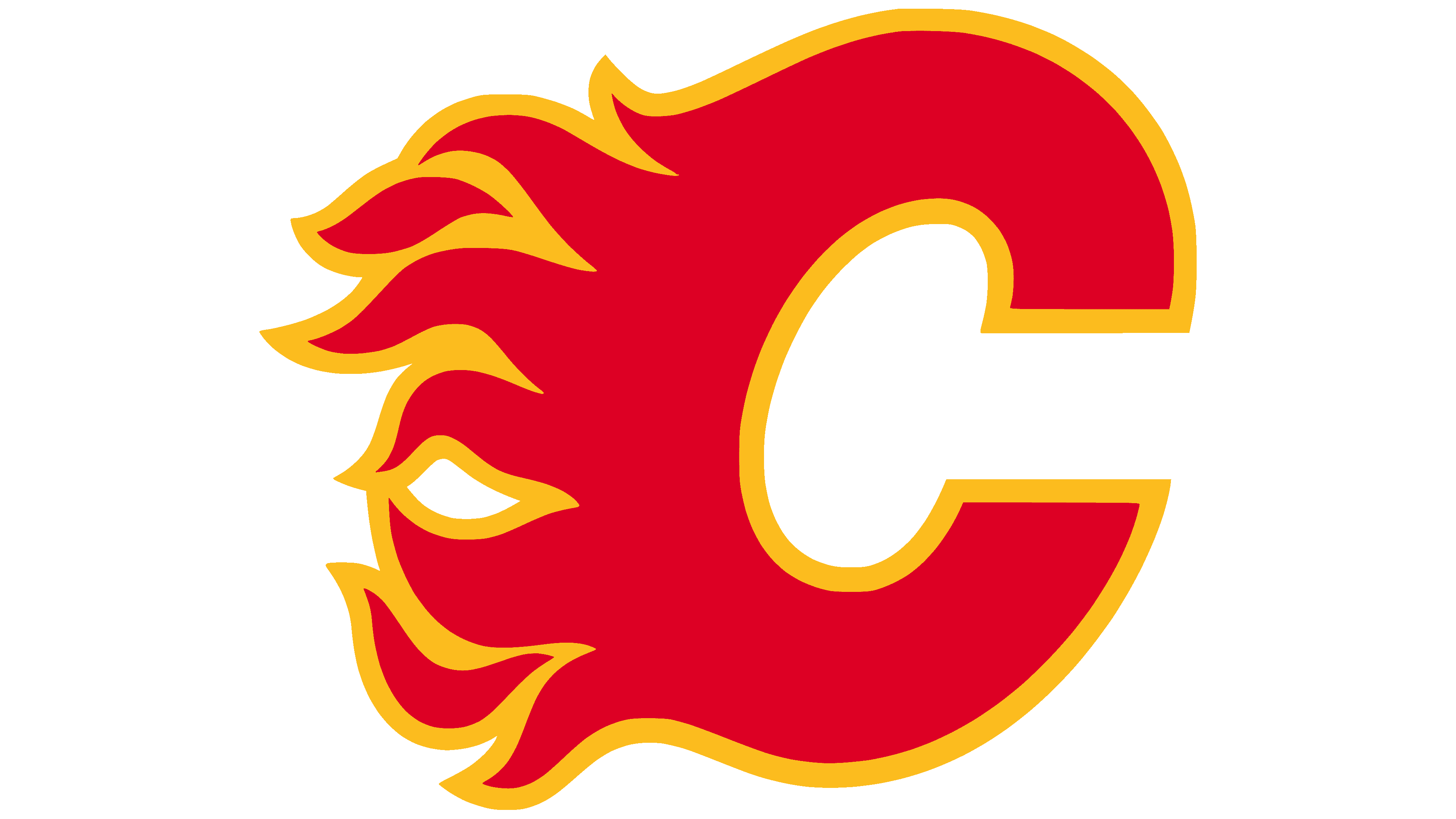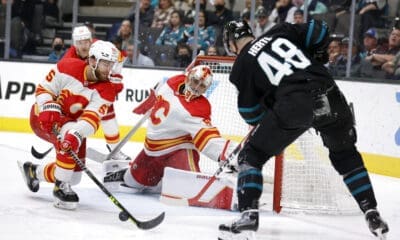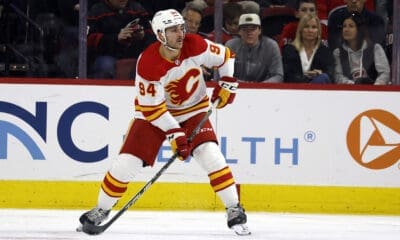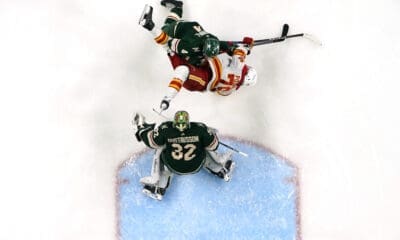Calgary Flames
Flames vs Canucks – Game One: Smart Plays and Michael Ferland
We're gonna take a brief look at some smart plays from last night that include TJ Brodie, Michael Ferland, and various other Flames.

Last night for large swaths of play it felt like the Flames had a lot of defensive zone time. Though, through that, coming back from being down 1-0, and then winning it with under a minute left the Flames made some smart decisions. A lot of it came with logical systems work in their own end or just very basic decisions that inevitably sent them up ice.
Because the game moves at such a fast pace it's always important to go back and examine the small intricacies in plays that often lead to amazing moments on the ice.
Example One – Mikael Backlund defensive zone draw (First Period)
In the first sequence we have a defensive zone start where Mikael Backlund loses the draw, but smart play by the Flames and a turnover in the neutral zone allow them to get a shot on net. The sequence is great for a couple reasons: the first showing how the Flames are able to get our of their zone, and the second being how reading a play can produce a shot on net.
Burrows fires the puck around the boards to start a play behind the net for the Sedins to cycle the puck. Backlund and Deryk Engelland head along the right of Jonas Hiller to try and shut it down. TJ Brodie heads to the left of Hiller to cover that side.
Brodie collides with Henrik Sedin falling down and it forces Henrik to pass behind the back to Daniel Sedin. Backlund reads the play and intercepts it. Sam Bennett is ready along the half-boards for the puck if it goes that direct.
Backlund reading the play passes it up the boards to a ready and waiting Bennett, though he loses possession of the puck getting out of the zone. Fortunately Mikael is following along up the boards with the play.
The turnover heads right onto Backlund's stick, sending him up ice. After a zone entry with the puck carried in, he gets a shot off. Though it's not the most quality of shots by any means, it allows for an offensive zone faceoff to happen. Here is the full video of the sequence below:
Why it worked:
Example Two – TJ Brodie is a machine
Brodie did this sort of thing throughout this season, just as he did it last season, too. We all know how superb of a puck mover he is but this is just an example of how strong he is with the puck:
The end to end zone entry created a shot attempt. Though not the most superb in quality, it was an example of just how effective Brodie can be.
So the immediate issue is the three Flames stuck behind the play. Ferland comes in quickly and as Burrows stops to set the play up, he hits him, forcing a turnover.

Though Ferland is only able to carry to the Canucks blueline and force the play back out, it stands out as an example of why Michael Ferland is such a great kid. Here is the full sequence leading up to it and the play after:
Why it worked:
- Calgary is able to create some offensive zone time thanks to Kris Russell keeping the puck in the Canucks zone.
- A pass from Matt Stajan to Ferland coming in goes high and wide but it’s still a great chance for the young forward.
- The Flames keep the puck onside with a Josh Jooris hit and turnover along the half-boards. Dennis Wideman gets the final shot attempt on net that is blocked and sent out of the zone.
Who is this kid?
I call Ferland "Lance Bouma Jr" for a lot of reasons. Their play is incredibly similar in many regards with the hitting, gritty play along the boards, going to the net, and ability to jump up in the play.
The difference lies within his offensive abilities: Bouma wasn't a capable scorer in the CHL. The transition of CHL forwards who don't score at a capable pace to the NHL is basically non-existent. Though no knock against Bouma, as he does what he does very capably.
Ferland, on the other hand, was able to produce in his draft +1 year (23G, 33A in 56GP) and in his draft +2 year (47G, 49A in 68GP). From there he's been a 0.52 PPG guy in the AHL (13G, 20A in 64GP) Not bad for a kid for who was drafted 113th overall (5th round) in 2010.
He's proving to be a bottom-six player in the NHL who can at the very least play. At 6'1 and 225lbs, he already has a foundation for being ahead of a number of players in the organization's depth chart. What comes next is ensuring he develops into a player who can play tough minutes and competition but can also chip in offensively. Next season, it's very possible to see him beat out players for a permanent roster spot with the team in Calgary.
We know that when he goes to the net chances happen:
Example Four – Gaudreau's two-on-one
How great was that Brodie play with 2 minutes to go. Takes the hit in the corner, then gets back into the play to get on a 2 on 1 with JG13
— Caleb (@CLIB542) April 16, 2015
To set the situation up we have Shawn Matthias tip the puck into the Flames zone. As Brodie heads back to get the puck you see Derek Dorsett come into the play and line up Brodie for a big hit.
Schlemko gaining possession of the puck from behind the net after Brodie took the hit sends it up the boards. I've circled the puck for easy identification. The play then heads up the boards into the neutral zone.
One Canuck is left way back in the Flames’ zone while Dorsett and Matthias chase after. Chris Tanev tries to prevent the saucer-pass from Jiri Hudler to Gaudreau. Gaudreau heads up ice with TJ Brodie, leading to a scoring chance on Lack.
Here is the full sequence in its entirety:
Why it worked:
Example Five – Sam Bennett screen and late third period play
We’ll close with a really basic but simple decision for the rookie who was responsible for Kris Russell’s game winner. The first part of the sequence happens with 1:23 remaining in the period. As the puck is cycled back around the boards, Russell pinches. He keeps the puck onside as Sam Bennett mows over Ronalds Kenins which allows Backlund to gain possession:
The Flames continue to keep the puck onside, working to cycle the puck. Joe Colborne tries to do something but inevitably it falls back to Bennett who sets up in the corner after Russell feeds him the puck. Here’s the key to this play though: Bennett is trying to feed David Jones going to the net and misses:
Wideman is able to get the puck and pass to Russell who blasts it home with Bennett obstructing the view in front of Lack:
Here's an alternate angle of the initial CBC replay showing Bennett's pass, followed by entering to help screen the goalie:
Finally, let's watch the full sequence happen:
Closing thoughts:
Overall the game had some positives and some opportunities for the club. The Flames are lucky that a few bounces went their way and they came out winning the first game. The persistence of Backlund and Bennett throughout the game is still a fantastic example of what happens when you add skilled players to the lineup who make things happen.
by Mike Pfeil








